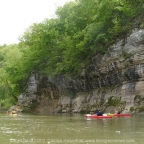Grant Will Go Toward Master Plan for the Historic Route 66 Bridge over the Meramec River
St. Louis, MO (March 22, 2010) Today, Landmarks Association of St. Louis, Inc. was awarded a $3,500 grant by the National Trust for Historic Preservation from the Missouri-Kansas Preservation Fund. The seed grant funds will launch the first phase of a multi-phased project to develop a master plan for the Historic Route 66 Bridge over the Meramec River.
Master Plan for the Historic Route 66 Bridge over the Meramec River
The master plan for the bridge will serve as a long-range plan for the future use of the bridge and its surrounds as historical resources. An economic feasibility study (which is part of the master plan) will examine preservation and rehabilitation costs, as well as physical enhancement opportunities such as the placement of overlooks, seating, handicap accessible viewing platforms, and educational signage in the park. These enhancements will help build an identity for the project, educate the public about the bridge as a historical resource, and distribute information about the process being undertaken currently.
The Meramec River Bridge is an important resource associated with Route 66 in Missouri. It was specifically constructed for the historic highway, and is one of only four similarly designed bridges in the state. When the road was bypassed by Interstate-44, the bridge was likewise evaded and fell into disrepair. The master plan funded by the grant is a critical step in stabilizing the bridge for future renovation and use.
Landmarks Association serves as fiscal agent for the bridge and has been working closely with the bridge’s stakeholders – a strong partnership of over twenty local, state and national organizations working to preserve the bridge as a vital tourism, recreational and historic asset.
“Without organizations like Landmarks and the Meramec River Bridge stakeholders, communities and towns all across America would have a diminished sense of place,” said Stephanie Meeks, president of the National Trust for Historic Preservation. “The National Trust for Historic Preservation is honored to provide a grant to Landmarks, which will use the funds to help preserve an important piece of our shared heritage.”
The National Trust for Historic Preservation dispenses small grants for local projects through the National Trust Preservation Funds grant program. The grants range from $500 to $5,000 and have provided over $5.5 million dollars of funding since 2002. They are awarded to nonprofit groups, educational institutions and public agencies, and must be matched, at least dollar for dollar, with public or private funds. Preservation Funds grants are being used nationally for such wide-ranging activities as consultant services for rehabilitating buildings, technical assistance for tourism that promotes historic resources and educating children about their heritage. These grants are often the deciding factor on whether historic buildings or sites can be saved for future generations.
For more information on National Trust for Historic Preservation’s Preservation Fund grants, visit: www.PreservationNation.org/resources/find-funding/grants/.
About Landmarks Association of St. Louis, Inc.
Landmarks Association of St. Louis (http://www.landmarks-stl.org/) was incorporated in 1959 as a not-for-profit agency, focusing on the preservation, enhancement, and promotion of St. Louis’ (and the surrounding area’s) architectural heritage. The agency’s original goals addressed rampant destruction of the city’s historic buildings and landmarks prompted by urban renewal and slum-clearance. Today, Landmarks continues to focus on the preservation and enhancement of local and regional historical resources, encouraging sound planning and good contemporary design.
About the National Trust for Historic Preservation
The National Trust for Historic Preservation (www.PreservationNation.org) is a non-profit membership organization bringing people together to protect, enhance and enjoy the places that matter to them. By saving the places where great moments from history – and the important moments of everyday life – took place, the National Trust for Historic Preservation helps revitalize neighborhoods and communities, spark economic development and promote environmental sustainability. With headquarters in Washington, DC, nine regional and field offices, 29 historic sites, and partner organizations in all 50 states, the National Trust for Historic Preservation provides leadership, education, advocacy and resources to a national network of people, organizations and local communities committed to saving places, connecting us to our history and collectively shaping the future of America’s stories.





 Posted by Missouri66
Posted by Missouri66